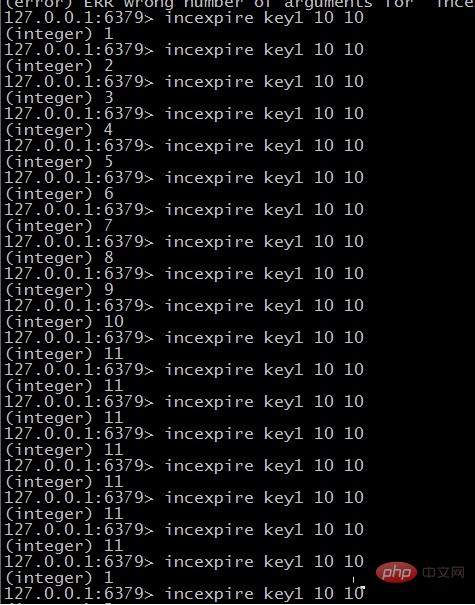How to add redis command

Redis has become the standard cache for Internet companies due to its excellent features of high performance and lightweight. Sometimes we want to add some custom commands, mainly in scenarios where Redis is heavily used. , like rush buying scenarios, it is necessary to ensure the transactionality of multiple Redis commands. If there is no good atomicity guarantee, data inconsistency problems may easily occur.
Although the official transaction plan is given, if it is necessary to make a judgment based on the return value of a certain command before proceeding to the next step, the transaction plan will not be able to cope with it.
Today we will use a practical case to describe how to add a Redis command. This command is mainly used in anti-swipe scenarios:
It is often necessary to ban a certain IP or a certain user for a period of time. If this command is not used, the solution is as follows:
First incr, and then determine whether it is 1. If it is 1, set the expiration time. It can be seen that if the first client that initiates the incr request hangs up during high concurrency, the key will not expire.
The command to be written today is used to ensure this transaction. The server side ensures that if the value of the key is 1, the expiration time is set.
The command usage is as follows:
incexpire key expireTime maxNum
key: the key to be processed
expireTime: expiration time, in seconds. If you write 10, it means that the key will expire in 10 seconds. ;
maxNum: Indicates the amount to which it will increase until it stops increasing. If it is set to 10, the maximum value returned is 11. Returning 11 means it has been exceeded;
2. Writing commands
1. Download the redis code
The Redis version used in this article is 3.2.11;
Download the code and cut to the 3.2.11 branch
git clone https://github.com/antirez/redis
2.Writing and adding Command code
1) Add a new command to the redisCommandTable structure in src/server.c
struct redisCommand redisCommandTable[] = {redisCommandTable is an array, each item represents a redis command, and the first one represents a command The second one is the actual processing function, and the third one is the number of parameters. The others will not be discussed in detail.
2) Add a function declaration in src/server.h:
void incrExpireCommand(client *c);
3) Then add a file as ljh.c (name it yourself) and add the following code:
#include "server.h"
4) Add a new file ljh.o in src/Makefile
REDIS_SERVER_OBJ=adlist.o quicklist.o ae.o anet.o dict.o server.o sds.o zmalloc.o lzf_c.o lzf_d.o pqsort.o zipmap.o sha1.o ziplist.o release.o networking
The execution effect is as follows

You can see that after key1 is increased to 11 It no longer increases, and after 10 seconds, it becomes 1 again.
Finally, we still have to ask ourselves whether it is necessary to add Redis commands in our scenario. If necessary, we must grasp the responsibilities between each layer and do not let Redis end up processing business; generally It is said that the middleware layer generally handles more general functions. The lower layers should be more stable and the less changes are, the normal situation is.
For more related knowledge, please pay attention to redis introductory tutorialcolumn
The above is the detailed content of How to add redis command. For more information, please follow other related articles on the PHP Chinese website!

Hot AI Tools

Undresser.AI Undress
AI-powered app for creating realistic nude photos

AI Clothes Remover
Online AI tool for removing clothes from photos.

Undress AI Tool
Undress images for free

Clothoff.io
AI clothes remover

Video Face Swap
Swap faces in any video effortlessly with our completely free AI face swap tool!

Hot Article

Hot Tools

Notepad++7.3.1
Easy-to-use and free code editor

SublimeText3 Chinese version
Chinese version, very easy to use

Zend Studio 13.0.1
Powerful PHP integrated development environment

Dreamweaver CS6
Visual web development tools

SublimeText3 Mac version
God-level code editing software (SublimeText3)

Hot Topics
 1664
1664
 14
14
 1423
1423
 52
52
 1317
1317
 25
25
 1268
1268
 29
29
 1247
1247
 24
24
 How to build the redis cluster mode
Apr 10, 2025 pm 10:15 PM
How to build the redis cluster mode
Apr 10, 2025 pm 10:15 PM
Redis cluster mode deploys Redis instances to multiple servers through sharding, improving scalability and availability. The construction steps are as follows: Create odd Redis instances with different ports; Create 3 sentinel instances, monitor Redis instances and failover; configure sentinel configuration files, add monitoring Redis instance information and failover settings; configure Redis instance configuration files, enable cluster mode and specify the cluster information file path; create nodes.conf file, containing information of each Redis instance; start the cluster, execute the create command to create a cluster and specify the number of replicas; log in to the cluster to execute the CLUSTER INFO command to verify the cluster status; make
 How to clear redis data
Apr 10, 2025 pm 10:06 PM
How to clear redis data
Apr 10, 2025 pm 10:06 PM
How to clear Redis data: Use the FLUSHALL command to clear all key values. Use the FLUSHDB command to clear the key value of the currently selected database. Use SELECT to switch databases, and then use FLUSHDB to clear multiple databases. Use the DEL command to delete a specific key. Use the redis-cli tool to clear the data.
 How to read redis queue
Apr 10, 2025 pm 10:12 PM
How to read redis queue
Apr 10, 2025 pm 10:12 PM
To read a queue from Redis, you need to get the queue name, read the elements using the LPOP command, and process the empty queue. The specific steps are as follows: Get the queue name: name it with the prefix of "queue:" such as "queue:my-queue". Use the LPOP command: Eject the element from the head of the queue and return its value, such as LPOP queue:my-queue. Processing empty queues: If the queue is empty, LPOP returns nil, and you can check whether the queue exists before reading the element.
 How to configure Lua script execution time in centos redis
Apr 14, 2025 pm 02:12 PM
How to configure Lua script execution time in centos redis
Apr 14, 2025 pm 02:12 PM
On CentOS systems, you can limit the execution time of Lua scripts by modifying Redis configuration files or using Redis commands to prevent malicious scripts from consuming too much resources. Method 1: Modify the Redis configuration file and locate the Redis configuration file: The Redis configuration file is usually located in /etc/redis/redis.conf. Edit configuration file: Open the configuration file using a text editor (such as vi or nano): sudovi/etc/redis/redis.conf Set the Lua script execution time limit: Add or modify the following lines in the configuration file to set the maximum execution time of the Lua script (unit: milliseconds)
 How to use the redis command line
Apr 10, 2025 pm 10:18 PM
How to use the redis command line
Apr 10, 2025 pm 10:18 PM
Use the Redis command line tool (redis-cli) to manage and operate Redis through the following steps: Connect to the server, specify the address and port. Send commands to the server using the command name and parameters. Use the HELP command to view help information for a specific command. Use the QUIT command to exit the command line tool.
 How to implement redis counter
Apr 10, 2025 pm 10:21 PM
How to implement redis counter
Apr 10, 2025 pm 10:21 PM
Redis counter is a mechanism that uses Redis key-value pair storage to implement counting operations, including the following steps: creating counter keys, increasing counts, decreasing counts, resetting counts, and obtaining counts. The advantages of Redis counters include fast speed, high concurrency, durability and simplicity and ease of use. It can be used in scenarios such as user access counting, real-time metric tracking, game scores and rankings, and order processing counting.
 How to set the redis expiration policy
Apr 10, 2025 pm 10:03 PM
How to set the redis expiration policy
Apr 10, 2025 pm 10:03 PM
There are two types of Redis data expiration strategies: periodic deletion: periodic scan to delete the expired key, which can be set through expired-time-cap-remove-count and expired-time-cap-remove-delay parameters. Lazy Deletion: Check for deletion expired keys only when keys are read or written. They can be set through lazyfree-lazy-eviction, lazyfree-lazy-expire, lazyfree-lazy-user-del parameters.
 How to optimize the performance of debian readdir
Apr 13, 2025 am 08:48 AM
How to optimize the performance of debian readdir
Apr 13, 2025 am 08:48 AM
In Debian systems, readdir system calls are used to read directory contents. If its performance is not good, try the following optimization strategy: Simplify the number of directory files: Split large directories into multiple small directories as much as possible, reducing the number of items processed per readdir call. Enable directory content caching: build a cache mechanism, update the cache regularly or when directory content changes, and reduce frequent calls to readdir. Memory caches (such as Memcached or Redis) or local caches (such as files or databases) can be considered. Adopt efficient data structure: If you implement directory traversal by yourself, select more efficient data structures (such as hash tables instead of linear search) to store and access directory information




